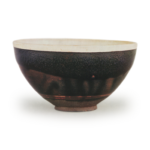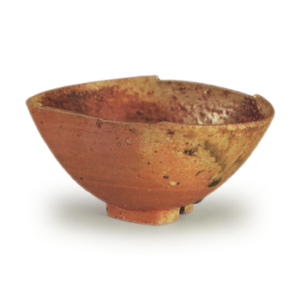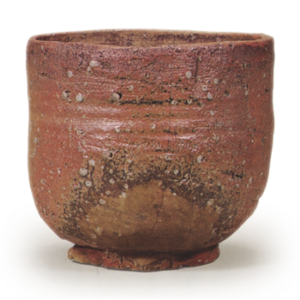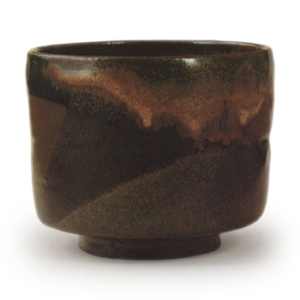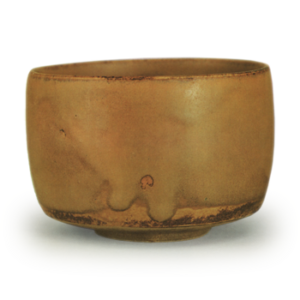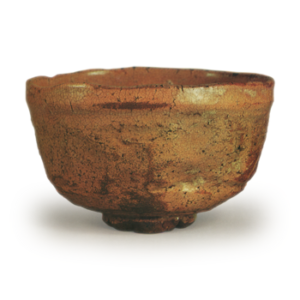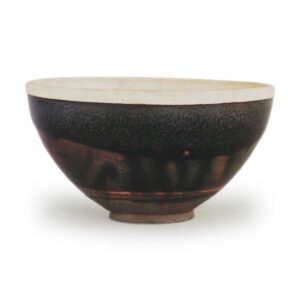
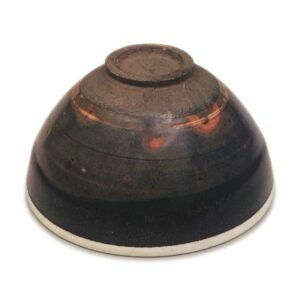
Important Cultural Property
Fujita Art Museum
Height: 7.7 – 8.2 cm
Diameter: 14.9 – 15.0 cm
Outer diameter of foot ring: 5.0 – 5.2 cm
Height of foot ring: 0.6 cm
This is the same type of oil spot tenmoku as the previous piece, but instead of a metal border, it has a white makeup border, and apart from the white border, the clay and glaze are almost the same as the previous piece, and it is probably from a kiln in the north. The use of the unique technique of white slip and the tone of the white slip suggest that it may have been produced in a certain kiln of the Cizhou ware type. The clay seems to have been made to produce a whitish finish, and this can be seen in the areas where the glaze has worn thin, leaving the fingerprints of the potter’s hands. The part of the foot ring that is visible is covered with a thick layer of iron-rich slip, so the original white of the clay is hidden. The Ryuko-in and Fujita Museum oil spot bowls that we will look at later also have the same type of slip. It seems that this was done in an attempt to make the bowl look like the bowls from the original Jingdezhen kilns, which have a darker clay body.
The smooth, bowl-shaped, plain form, and the way the wide, raised foot ring has been shaved is clearly the style of the Northern Kilns. On one part of the foot ring, you can see the marks left by the scraper when it was shaved. The glaze is also a double glaze, with a dark iron-based glaze applied to the base, and a light-colored water-based glaze applied on top. If you look at the side wall of the figure on the side, you will notice that the upper half has the usual oil-drop glaze, but the lower half has no oil drops and the color is lighter. This is because the upper water glaze has been applied over the lower glaze, unlike the examples of Tokugawa family oil-drop tenmoku. The “rabbit-hair” oil spots that are characteristic of tenmoku, and the rare “star” yohen patterns that appear on them, are phenomena that only occur when these two glazes overlap, so of course no grains or streaks appear in areas where only the upper glaze has been applied, as in this example, where the lower glaze has not been applied properly. In the case of Tenmoku ware from the Tenkyo kiln, there are no such mistakes, so it can be said that the double glazing technique is not apparent.
Now, in this Tenmoku ware, the outer glaze is not very good, and the oil spots are not particularly impressive, but the inside is well-formed and beautiful. The background is a deep black glaze with a slightly sepia tone, and it is covered with fine silver crystals. There is a bubble in the center of the glaze, and the grains are a little large, but the rest of the glaze is uniform. However, like the one in the Tokugawa Art Museum collection, this tea bowl also has few iridescent patterns. The way the glaze was applied probably didn’t allow for the ideal way of applying the luster film.
Finally, let’s touch on the white rim. How was this applied? Common sense would suggest that, before glazing, a layer of white slip would be applied to the rim only, and then a lower glaze would be applied over this. Then, in the area of the white rim, the lower glaze would be scraped away to reveal the white slip layer underneath. After this, a water glaze would be applied to the whole piece and fired. However, in the case of this tea bowl, the surface of the white rim on the outside seems to be a little higher than the surface of the Tenmoku glaze underneath. According to the technique I just described, the white rim should naturally be lower than the rest of the bowl, so it seems that some other method was used.
The white rim and the bowl body are joined tightly, so if it was done, it would have to be done by placing a soft clay string around the rim of the bowl and shaping it while turning the potter’s wheel, and then attaching it tightly to the rim of the bowl. However, the fatal flaw in this method is that the bowl is dry and the string is wet, so they don’t blend together. Eventually the string will break in various places. I even want to ask the artist of this work what happened.

